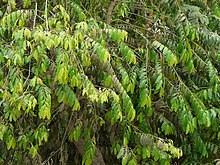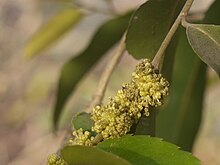Putranjivaceae
Putranjivaceae
Family of trees
Putranjivaceae is a rosid family that is composed of 218 species in 2 genera of evergreen tropical trees that are found mainly in the Old World tropics, but with a few species in tropical America.[2][3]
This article needs additional citations for verification. (April 2013) |
Members of this family have 2-ranked[clarification needed] coriaceous leaves, which, if fresh, typically have a radish-like or peppery taste. The flowers are fasciculate and usually small, and the fruits of these species are a single-seeded drupe crown by the persistent stigmas. This family has its origin in Africa and Malesia. It is the only family outside Brassicales that produces mustard oils.

